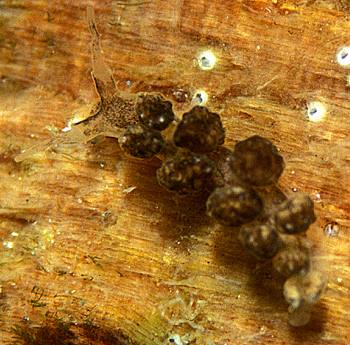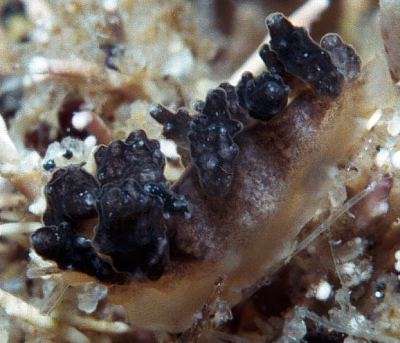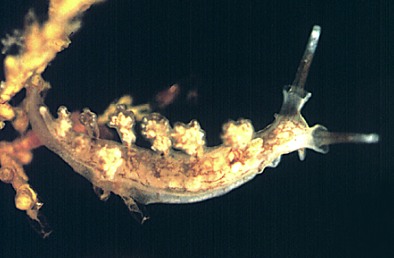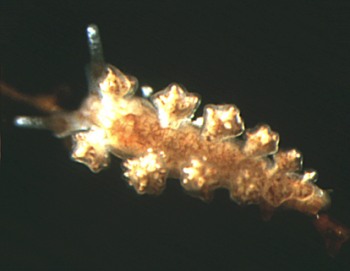
Doto cf. pita
Order: NUDIBRANCHIA
Suborder: DENDRONOTINA
Family: Dotidae
PHOTO
Hachijo Island, Japan., May 2002. Photo: Shouichi Kato.
Doto pita Marcus, 1955 was first described from Brazil and has since been recorded in the tropical west Atlantic from the Caribbean and as far north as Florida. Baba (1971) identified a similar looking animal from Japan as this species, but no detailed comparison of their anatomy has been undertaken. If the identification is correct then the occurrence of a species in both the west Atlantic and NW Pacific is almost certainly a result of human disturbance.
References:
• Baba, K. (1971) Anatomical studies on three species of Doto (D. bella, D. japonica, and D. pita) from Japan (Nudibranchia: Dendronotoidea: Dotoidae. Publications of the Seto Marine Biological Laboratory, 19(2/3): 73-79, Pls 4, 5.
• Edmunds, M. & Just, H. (1985) Dorid, Dendronotid and Arminid nudibranchiate mollusca from Barbados. Journal of Molluscan Studies, 51: 52-63
• Marcus, Er. (1957) On Opisthobranchia from Brazil (2). Journal of the Linnean Society of London, Zoology, 43: 390-486.
• Marcus, Ev. & Marcus, Er. (1963) Opisthobranchs from the Lesser Antilles. Studies on the Fauna of Curacao and other Caribbean Islands, 19(79): 1-76.
• Marcus, Er. (1955) Opisthobranchia from Brazil. Boletim da Faculdade de Filosofia, Ciencias e Letras. Universidade de Sao Paulo, Zoologia, 20: 89-261. (Pls. 1-30)
Rudman, W.B., 2002 (June 27) Doto cf. pita [In] Sea Slug Forum. Australian Museum, Sydney. Available from http://www.seaslugforum.net/find/dotocfpita
Related messages
Re: Doto sp from Peter the Great Bay
February 26, 2003
From: Alexei Chernyshev
Dear Bill,
Thanks for your comments. Unfortunately, I only have this photo and brief information from Mr. Ratnikov that the nudibranch mollusk was found in the south part of Peter the Great Bay in depth about 5-7 m. Doto is a new genus for the mollusk fauna of Russian coast of the Sea of Japan and I have sent this photo to you in the hope to identify this species (if it is possible).
Sincerely yours,
Alexei Chernyshev
tsher@bio.dvgu.ru
Dear Alexei,
As I said earlier, this species certainly looks similar to the one Baba identified as Doto pita. But Doto pita is a species from the tropical west Atlantic, so it as most unlikely resident of the much cooler waters of the Sea of Japan.
I wish it were easy to identify species of Doto but they cause problems inmost parts of the world, including the North Atlantic where they have been studied for 150 years. Clearly the external shape and colour is important, but only if considered in conjunction with the internal anatomy and aspects of their natural history, such as their food preferences. Although they can be irritating to identify they are certainly an exciting group to study in depth.
Best wishes,
Bill Rudman
Doto sp. from Sea of Japan
February 8, 2003
From: Alexei Chernyhev

Dear Dr. Rudman,
I have problem with identification of one nudibranch species. Unfortunately I haven't got this specimen but it was photographed by Mr. Alexander Ratnikov in Peter the Great Bay (Russian coast of the Sea of Japan) in 2002. Undoubtedly, it is Doto. This specimen is closest to "dark" form Doto cf. pita described from Hachijo Island by Shouichi Kato.
Thank you very much,
Alexei Chernyshev
Institute of Marine Biology
Vladivostok, Russia.
nemert@fromru.com
Chernyhev, A., 2003 (Feb 8) Doto sp. from Sea of Japan. [Message in] Sea Slug Forum. Australian Museum, Sydney. Available from http://www.seaslugforum.net/find/9062Dear Alexei,
Thanks for the photo. It does look quite like Shouichi Kato's photo, but as you will have seen in other messages on the Forum concerning the identification of species of Doto worldwide, a knowledge of their anatomy and their preferred food is essential for sensible identifications.
Best wishes,
Bill Rudman
Doto cf. pita from Japan
August 7, 2002
From: Nishina Masayoshi


Dear Bill,
I agree with your identification of Doto cf. pita. I have attached photos of my Doto cf. pita from Echizen coast Japan. Generally this Doto is said to live in or on hydroid Sertularella but my wife found the animal in bushy place covered with short red, green, brown algae. I am not sure where they lives.
Date:7 May 2002
Loc: Echizen coast, Fukui prif. Japan
Lengh: 5mm
Depth: 4m
Water temp: 20C degree
Photo C. Nishina taken at original place.
Best Regards,
Nishina Masayoshi
nishina@wips.co.jp
Masayoshi, N., 2002 (Aug 7) Doto cf. pita from Japan. [Message in] Sea Slug Forum. Australian Museum, Sydney. Available from http://www.seaslugforum.net/find/7702Thanks Nishina,
Sometimes it is easy to see what hydroid colony an aeolid is living and feeding on, but some species of hydroids don't form neat 'bushy' colonies, and sometimes species which normally form neat 'bushy' colonies, sometimes have a disorganised rambling network of stalks and stolons which become tangled up with plants and other colonial animals, including sponges. When that happens it is almost impossible to be sure just what the aeolid is eating.
Best wishes,
Bill Rudman
Doto cf. pita from The Japan Sea
August 2, 2002
From: Shigeru Hayashi

Dear Bill,
Here is some information on another species from the Japan Sea. This time, what we identify as Doto pita which lives on the hydroid Sertularella miurensis in May. This 6mm specimen was collected from Toyama Bay on May 12, 2002, and was eating a polyp of S. miurensis. The water temperature was to 16 degrees being. We confirmed its spawning and a larva with less than 1mm length, too.
D. pita can be observed in midsummer. It seems to emigrate to other Sertularella colonies because the seaweed that has Sertularella dies in the summer. Photos courtesy of the Takaoka Biological Club, Japan
Best wishes,
Shigeru Hayashi
jr9dsx@tko.fitweb.or.jp


Thanks Shigeru,
It is good to get photos of animals identified in Japan as Doto pita. As I discuss in Shoichi's message it is unlikely that this Japanese animal is the same as one from the western Atlantic. Also as Bernard Picton discusses in a recent message, species of Doto seem to have very specific food requirements. It is therefore good to get your information on the hydroid that the Japanese animal feeds on. Until the Japanese and Atlantic animals are studied anatomically I will keep those from Japan as Doto cf. pita.
Best wishes,
Bill Rudman
Doto pita? from Hachijo Japan
June 29, 2002
From: Shouichi Kato

Dear Bill,
Here is a photo of another nudibranch I found on the same driftwood as my earlier message on Fiona pinnata. This sea slug looks like Doto pita to me. They are smaller than 10mm in size. [Hachijo Island Japan, May 2002]. Is the habitat of Doto pita on driftwood?
Please advise.
Best regards,
S. Kato
regulus@edit.ne.jp
Kato, S., 2002 (Jun 29) Doto pita? from Hachijo Japan. [Message in] Sea Slug Forum. Australian Museum, Sydney. Available from http://www.seaslugforum.net/find/7270Dear Shouichi,
This certainly looks like the species that Baba (1971) has described from Japan as D. pita. But Doto pita was originally reported from Brazil (Marcus, 1955, 1977) and has subsequently been reported north to the Caribbean (Edmunds & Just, 1985). If this west Atlantic species also occurs in Japan, then the distribution is probably the result of human intervention (shipping etc.).
Do species of Doto normally live on driftwood? I have certainly found species of Doto on driftwood, but they are there because the hydroids they feed on are growing there. Hydroids are able to settle on any clean surfaces, so they can be found on drifting objects, but they can also be found on rocks, wharf piles, bouys etc - anywhere they can find to settle out of the plankton. At present I will call this Doto cf. pita.
• Marcus, Er. (1955) Opisthobranchia from Brazil. Boletim da Faculdade de Filosofia, Ciencias e Letras. Universidade de Sao Paulo, Zoologia, 20: 89-261. (Pls. 1-30)
• Marcus, Er. (1957) On Opisthobranchia from Brazil (2). Journal of the Linnean Society of London, Zoology, 43: 390-486.
• Marcus, Ev. & Marcus, Er. (1963) Opisthobranchs from the Lesser Antilles. Studies on the Fauna of Curacao and other Caribbean Islands, 19(79): 1-76.
• Baba, K. (1971) Anatomical studies on three species of Doto (D. bella, D. japonica, and D. pita) from Japan (Nudibranchia: Dendronotoidea: Dotoidae. Publications of the Seto Marine Biological Laboratory, 19(2/3): 73-79, Pls 4, 5.
• Edmunds, M. & Just, H. (1985) Dorid, Dendronotid and Arminid nudibranchiate mollusca from Barbados. Journal of Molluscan Studies, 51: 52-63
Best wishes
Bill Rudman
